Nano-CEMMS' Carrie Kouadio Finds Teaching Nanotechnology Rewarding
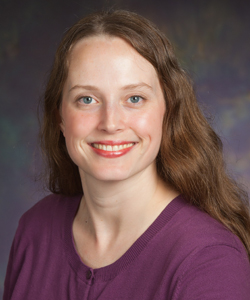
Carrie Kouadio, Nano-CEMMS eudcation coordinator
November 6, 2012
The Nano-CEMMS education program seems to have a pattern of offering top-notch educators stimulating science programs as bait, getting them hooked, then reeling them in. For example, the story of how Carrie Kouadio, an integral part of the Center for Nanoscale Chemical-Electrical-Mechanical Manufacturing Systems (Nano-CEMMS) education team ended up there is similar to those of several other members of the team: She was a science teacher who came to Nano-CEMMS to participate in teacher development to improve her skills and liked it so much that she stayed.
Pre Nano-CEMMS, Kouadio had been working in schools for several years when she realized she wanted to go back to school herself and get a Masters to teach science, which she did here at Illinois. It was at that point that she participated in a Nano-CEMMS pre-teacher institute led by Joe Muskin (Education Coordinator) and Marty Atwater (former Deputy Director/Nano-CEMMS), which literally changed her life. She remembers the impact of that first Nano-CEMMS event she attended.
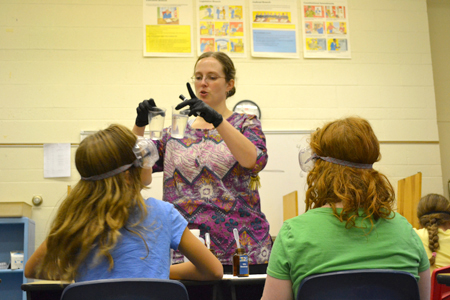
Kouadio demonstrates solutions the campers will be using to make mirrors for their kaleidoscopes.
"At that preservice teacher workshop, it was really wonderful. It was really well done; it was really interesting; the activities were fun and engaging and exciting, and it opened your mind to all the possibilities of science and engineering. So I came away from it the first day very reinvigorated about teaching science, which I think was probably the goal. So I was really happy to be able to come and take it further."
After that initial experience, Nano-CEMMS recruited her to do educational kits, and she liked it so much, she just stayed. Kouadio has been with Nano-CEMMS since 2006, and although for several years, she worked part time but still taught science in local schools, she has since become a full-time education coordinator.
Originally hired to disseminate the educational kits to teachers, Kouadio is still heavily involved in supplying materials to educators. Not only can teachers order materials and kits online, but they can access lessons online. Her first year, they sent out 35 kits; now they're up to around 209 a year, sending materials all over the states, even to Bosnia. And the remarkable thing is, the honor system is alive and well among these teachers; after they have finished using the kits, they actually ship them back. Nano-CEMMS has also developed a kit for Project Lead-the-Way, which teachers are required to purchase. Kouadio estimates that the materials arm of the education program has had quite an impact: "There have been at least 40,000 student experiences just with borrowed materials. And that's not including our classroom visits, our auditorium visits, and our sold kits."
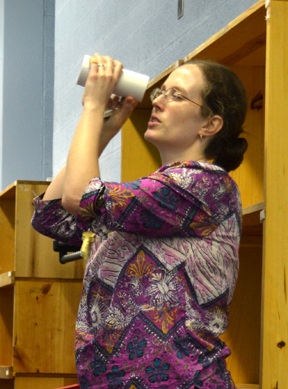
Carrie Kouadio looks through a kaleidoscope that utilizes student-made silvered mirrors. GIRRRLS camp participants made these during one nanotechnology session Kouadio taught in summer 2012.
Kouadio has held a number of positions in the field of education over the last 14 years. Unlike being a middle school teacher, who is limited to one age group or classroom, as a Nano-CEMMS educator, Kouadio has the opportunity to work with a variety of people, from young to old—students from kindergarten all the way through high school and even college, as well as adults. She works with well-educated folk, like teachers, and with kids who have just barely begun their educational journey. She could be in an elementary classroom on a given day, working with high school students doing a campus visit the next, and offering teachers in-depth professional development on the principles of nanotechnology the next week, with a two-day trip to Chicago for an event like the French/U.S. Science Festival sandwiched in between, all while preparing to teach a week-long camp for youngsters, like the Summer 2012 GIRRRLS camp.
While she might teach each age group about the same nanotechnology topic, such as introducing students to nanotechnology or making gold and silver nanoparticles, she is used to preparing programs for very disparate age groups. "We do definitely consider the age group when we're planning what we're going to do. We don't do an activity exactly the same every time. We always tailor it for the age group. We know the ages, and what they can do, and what are age-appropriate content and teaching methods for these different groups. So we take that into consideration." According to Kouadio, they alter the presentation, teaching method, and even the procedure based on age, the students' background, how much lab experience they have, and what kind of interests they have. "We really want to create a very high-quality experience for every group that we're with, so we think about each group individually."
One group Nano-CEMMS works with heavily, especially during the summer months, is teachers, for whom they provide professional development demonstrating cutting-edge nanotechnology experiments for the classroom. Having been a teacher herself, Kouadio finds working with teachers rewarding, especially being able to provide resources that might ease their work load a bit.
"We've worked with so many teachers, and we just respect teachers. But we also were teachers, so we know what their lives are like, and the things they have to do, and how difficult their jobs can be…It's exciting for us to be able to introduce teachers to these ideas and to reinvigorate them to teaching science, to give them new tools they can use in their classrooms, to be able to leave them materials to make it easy for them to use all these things in their classrooms… Because we know as a science teacher you spend a lot of time just gathering materials for your lab, preparing your lab. So if we can give them some high-quality activities and let them borrow all sorts of materials and give them what they need to carry out a lesson, it takes one thing off their plate."
Suppose they have prepared the lesson anticipating that the group with whom they will be working is at a certain level, and, based on the deer-in-the-headlights looks on the faces, it's clear that they're not getting it? No problem; they've encountered that before.
"Being teachers," responds Kouadio, "because at our root, we're teachers, as we're teaching, we are analyzing and trying to determine, "Is it going well, or is it not?" and we will change things as needed, depending on how the audience responds to us. I think that's the really good thing about the fact that we have been teachers, is that we have had to do that, so we have a lot of experience having to change a lesson midstream.
She goes on to share that they've gotten pretty good at improvising, at adapting what they had planned to meet their group's needs: "We want it to be a very high quality-experience and so that means if it looks like what we've decided to do is not going to work as well as we wanted, we will change it. And we'll do it fast, and we're good at being able to kind of quickly, 'OK, what can we do?' But on the other hand, we've done a lot of these, so we can kind of anticipate pretty well what will work well and what won't."
Kouadio also finds working with the children rewarding, especially the opportunity to get them excited about science.
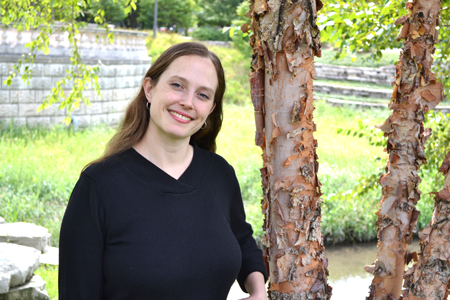
Carrie Kouadio on Engineering Quad outside of the Nano-CEMMS office in MEL.
"It's very exciting to me that our jobs really allow us to make an impact. This is something very important to me. I feel that it's a gift to have a job where you feel you are making an impact, and I do feel that we are making an impact. We see it with students where they come in and they say, 'This is so much fun; I want to do this some more; could I make some more mirrors?' Or they want to do more of the activities we're doing. And so it's clear to us that we're impacting students; we're getting them excited and interested in science and engineering."
She also believes that by getting the youngsters excited about science, they might possibly be steering some of them toward careers in science. "We're opening their minds so they realize there are more options for their lives than they may have considered. So they may have just thought, "Oh, I'm going to become a whatever.' But when we come in, we give them some more options. And we show them some interesting things that people are doing in those areas. So I find that a gift, to be able to let people know about all of these possibilities for their lives."
Not only has Kouadio had the opportunity to work with people from different age groups and educational levels, but she finds the opportunity to work with people from different ethnic and socio-economic backgrounds particularly rewarding. She shares an anecdote about an experience that stands out in her memory.
"We went down to the Saint Louis Science Center once, and there was a kid who came up, and you could tell he was very poor, but we taught him, as we were teaching everyone there…And it made me very happy we were there. I had the thought that some of these people that come to us, we might spark something in them that makes them consider going into science or engineering, and we might help them…So it's not that we're just getting people excited and interested, but we might actually help spur them towards a career or a life path that would help them tremendously to have a better life."
Story and photographs by Elizabeth Innes, Communications Specialist, I-STEM Education Initiative
More: Faculty Feature, Nano-CEMMS, Teacher Professional Development, 2012
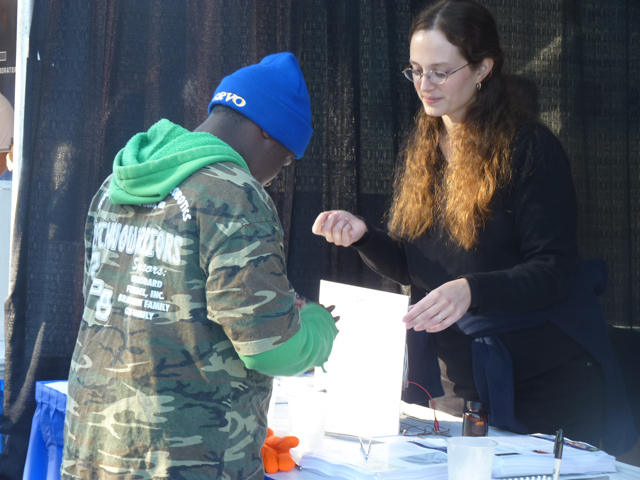
Carrie Kouadio works with a student at the 2010 U.S. Science and Engineering Festival (photograph courtesy of Carrie Kouadio).













.jpg)
















